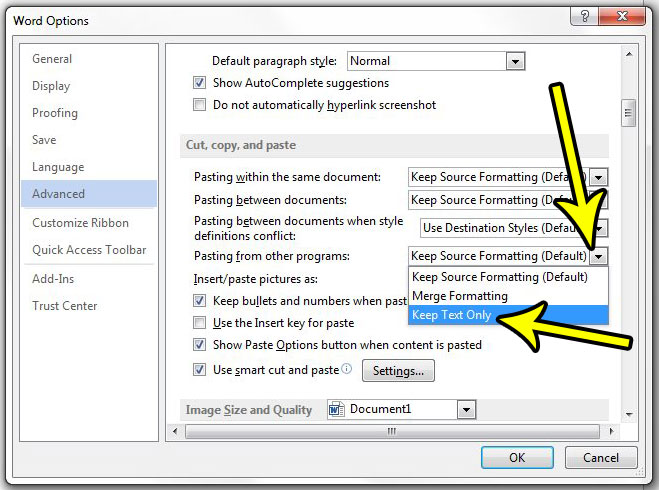Word for Office 365 Word 2019 Word 2016 Word 2013 Word 2010 Word 2007When you cut or copy text and then paste it into your document, do you want the text to look the way it did originally, or do you want it to look like the surrounding text in its new location? Sometimes you may want one option, but in another situation you may want the other.For example, if you insert a quotation from a Web page into your document, you may want the quotation to appear exactly as it does on the Web page. On the other hand, if you copy text from one of your own documents to another, you may prefer that the copied text look like the text in the destination document.In Word, you can choose either of these options each time that you paste text. If you typically want one of the options, you can set it as the default for pasted text.
This article explains how. The text that you move or copy can have a font or other kind of formatting applied to it, such as bold or italic, that differs from the document where you are pasting the text. For example, you can move or copy text that is bold, 10-point Times New Roman, and paste it next to text that is regular, 11-point Calibri. If you want the pasted text to be in Times New Roman instead of Calibri, you can preserve its look.Select the text that you want to move or copy, and then press CTRL+X to move the text, or press CTRL+C to copy the text.Click where you want to paste the text, and then press CTRL+V.Click the Paste Options button, which appears after you paste the text.If you don't see a Paste Options button, press CTRL+Z to undo the paste, and then turn on the option for displaying it. For procedures, go to.Click Keep Source Formatting. If you paste a portion of a paragraph from another Word document, and styles such as Normal, Heading 1, and so on are defined differently in each document, the Paste Options button can display Keep Source Formatting as selected, yet the pasted text will not look like the text in the original document.

This is because the format of the text in the original document is governed by its paragraph style. If you want to preserve its original formatting, do the following:.When you cut or copy the original text, be sure to include the paragraph mark (¶).To display the paragraph mark, click Show/Hide ¶ in the Paragraph group on the Home tab.Paste the text.Click the Paste Options button, which appears after you paste the text.If you don't see a Paste Options button, press CTRL+Z to undo the paste, and then turn on the option for displaying it. For procedures, go to.Delete any unwanted text that precedes the end of the paragraph. The text that you move or copy can have a font or other kind of formatting applied to it (such as bold or italic) that differs from the document where you are pasting the text.
Microsoft Word Paste Without Formatting
In recent versions of Linux, you can use CTRL + Shift + V to paste text without formatting. Like Windows, you can paste into a text editor (try Gedit if you need one) to strip the formatting before pasting elsewhere. The above browser extensions will work in Linux as well. You’re a Pasting Wizard.
For example, you can move or copy text that is bold, 10-point Times New Roman, and paste it next to text that is regular, 11-point Calibri. If you want the pasted text to be in Calibri to match the surrounding text, follow these steps.Select the text that you want to move or copy, and then press CTRL+X to move the text, or press CTRL+C to copy the text.Click where you want to paste the text, and then press CTRL+V.Click the Paste Options button, which appears after you paste the text.If you don't see a Paste Options button, press CTRL+Z to undo the paste, and then turn on the option for displaying it. For procedures, go to.Do one of the following:.If the text that you are pasting includes portions of formatting that you want to preserve, such as bold or italicized words, click Match Destination Formatting.If you want to remove all of the original formatting from the text that you are pasting, click Keep Text Only.Note that if your selection includes content that is not text, the Keep Text Only option discards the content or converts it to text.
For example, if you use the Keep Text Only option when you paste content that includes pictures and a table, the pictures are omitted from the pasted content, and the table is converted to a series of paragraphs.If your selection includes a bulleted or numbered listThe Keep Text Only option may discard the bullets or numbering, depending on the default setting for pasting text in Word.